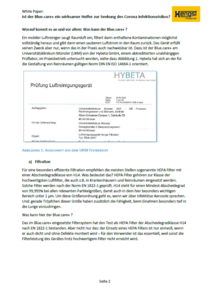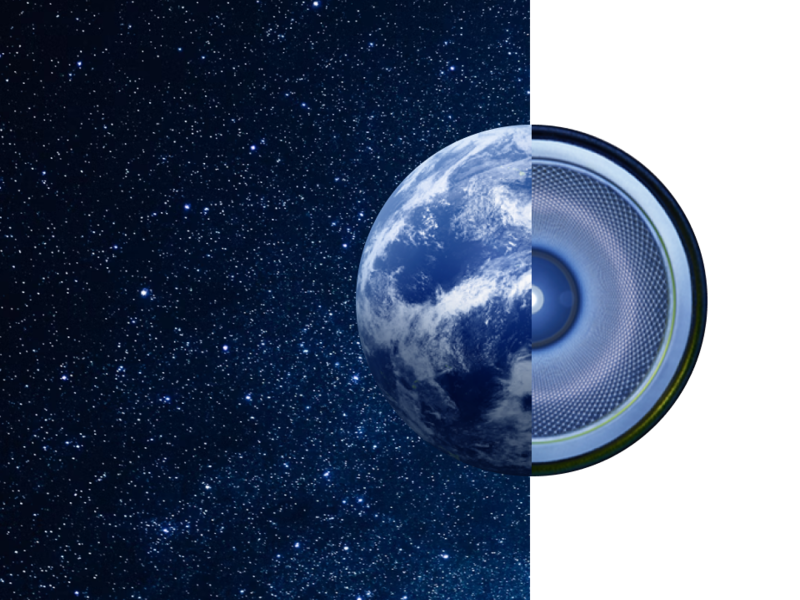Technology
Mobile air purifiers
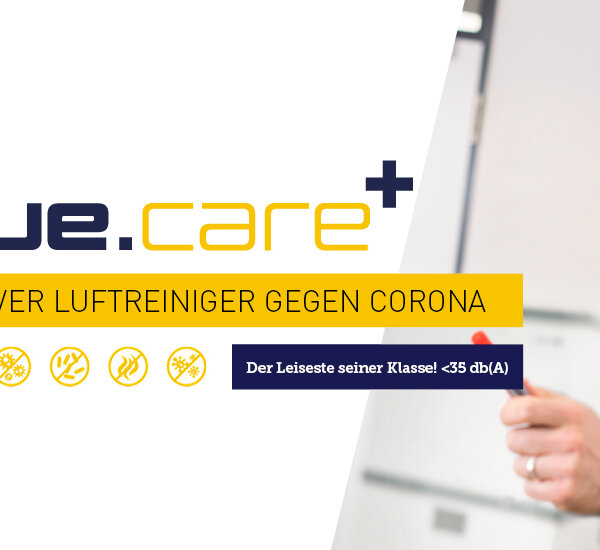
Make short work of Covid-19!
Blue.care+ Air Purifier against Covid
Whether classrooms, teaching and seminar rooms, doctors' surgeries, offices or restaurants - the Blue.care+ antiviral air purifier ensures clean, healthy indoor air everywhere. The latest development from filter system expert Hengst SE has been tested by scientists at the Westfälische Wilhelms-Universität Münster and is already in use in hundreds of schools, daycare centers, surgeries, offices and restaurants.
After just 10 minutes, the viral load in the room air is reduced by 50%, after just 30 minutes even by 90% (room size 80 m²) at an air exchange rate of 6 times per hour.
The HEPA class H14 combi filter achieves a filter efficiency of ≥ 99.995 %. Fine dust, allergens, bacteria and the smallest viral-contaminated aerosol droplets are reliably filtered out of the room air. And without the use of UV-C radiation.
The noise level in continuous operation at 800 m³/h nominal volume flow is below 35 db(A). The Power Diffusor Pro distributes the intake air evenly towards the ceiling without any disruptive draughts. This achieves the best possible air circulation in the entire interior. The robust, flow-optimized design and energy-efficient technology guarantee safe continuous operation and low energy consumption.
The air purifier is controlled via a clear display. The room size can be conveniently entered here, which automatically sets the optimum performance of the purifier, and the air exchange rate can also be adjusted at any time (a 4-fold exchange rate per hour is recommended). A weekly schedule can be programmed in the menu and a silent or booster function and a run-on time can be activated. The filter saturation and the room air quality are displayed and the device can be controlled via a weekly schedule. The air purifier also has a daylight sensor and a timer.
Air purifiers for schools, daycare centers and educational institutions
Politicians, administrations, providers and management aim to keep schools and daycare centers open despite the coronavirus pandemic. Teachers, educators, parents and children expect optimum protection. The Blue.care+ mobile air purifier meets all the criteria for effectively purifying the air in group rooms and classrooms - even in rooms where ventilation is not possible.
As the Blue.care+ air purifier meets the funding criteria of many federal states, it is possible to cover up to 100% of the acquisition costs with subsidies.
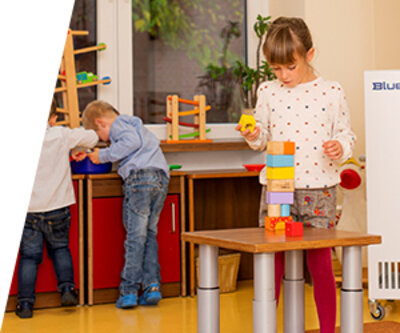
Air purifiers for offices and business premises
Company health managers, HR managers, managing directors and site managers are faced with a dilemma: they have to weigh up the protection of their employees against the potential loss of productivity when working from home. In some industries, working from home is not even possible.
The Blue.care+ antiviral air purifier offers a safe and inexpensive solution here. Ideally suited for offices and business premises, it meets all technical requirements, has been clinically tested and massively reduces the indirect risk of infection.

Air purifiers for medical practices
Practice owners are responsible for the well-being of their patients and employees. Despite all measures to keep suspected coronavirus cases as far away from the practice as possible, it cannot be ruled out that infected patients will enter the practice rooms and thus endanger everyone else present.
The Blue.care+ mobile air filter for practices, clinically tested by scientists at Münster University Hospital, ensures clean air in every practice.
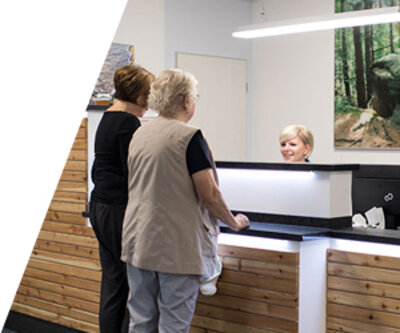
Air purifiers for restaurants, cafés and hotels
Operators of restaurants, cafés, ice cream parlors, hotels and the like are also facing a major challenge: how can guests be effectively protected? And how can they operate economically under coronavirus conditions? The answer is the use of the Blue.care+ antiviral air purifier in hotels and restaurants. With comparatively low acquisition costs, strong filter power and a high air exchange rate, it minimizes the indirect risk of infection with coronaviruses. The Blue.care+ creates a pleasant and safe indoor climate for your guests' undisturbed stay.

What can the air purifier do? How many devices do I need? Here you will find (almost) all the answers to your questions at a glance:
Technical Specifications L
Technical Specifications Blue.care+ (variant L)
| Product name | Blue.care+ (variant L) |
| Dimensions | 1.68 x 0.73 x 0.56 m |
| weight | 135 kg |
| Noise level | Sound pressure level at 1 m distance at 800 m3/h 35 db(A), sound pressure level at 1 m distance at maximum volume flow at 2000 m3/h 46.2 db(A) |
| Max. Air flow rate | 1,800 m³/h |
| Air exchange rate | Adjustable via the touch display. Recommendation according to VDI-EE 4300 Sheet 14, the device should be set to 4 air changes per hour. |
| Power supply | 230 Volt / 50Hz |
| Power consumption | 250 watts at nominal volume |
| Filter efficiency | ≥ 99.995 % of all particles incl. bacteria and viruses |
| Filter combination | HEPA H14 combi filter according to standard EN 1822 or ISO 29463 |
| Version | L |
Test report on the Blue.care+ air purifier from Münster University Hospital: Download
Technical Specifications M
Technical Specifications Blue.care+ (variant M)
| Product name | Blue.care+ (variant M) |
| Dimensions | 1.08 x 0.45 x 0.40 m (with handles and door) |
| weight | 50 kg |
| Noise level | 42 dB(A) - Sound pressure level at a distance of 1 m at nominal volume flow rate |
| Nominal volume flow | 600 m³/h |
| Max. Air flow rate | 770 m³/h |
| Air exchange rate | 6 x per hour for a room up to 50 m² |
| Power supply | 230 Volt / 50Hz |
| Consumption at nominal volume flow | 75 watts |
| Filter efficiency | ≥ 99.995 % of all particles incl. bacteria and viruses |
| Filter combination | HEPA H14 main filter and F7 activated carbon pre-filter according to standard EN 1822 or ISO 29463 |
| Version | M |
Downloads L
Downloads M
Downloads Blue.care+ (variant M)

Original operating instructions
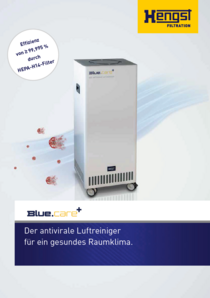
Data sheet

Press release
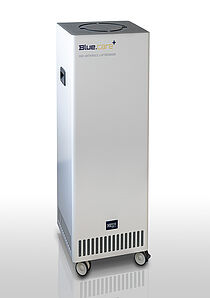
Image data
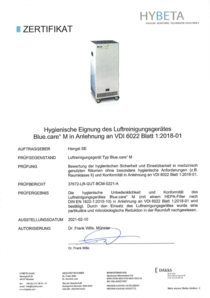
Certification
FAQ
FAQ's Blue.care+
What are aerosols?
Aerosols are generally defined as a fine distribution of tiny suspended particles in a gas, in our case the air.
The current discussion focuses primarily on droplets of different sizes and quantities that people exhale with the air when breathing and speaking. Larger droplets (> 5 µm) sink quickly due to gravity, while small and tiny droplets can float in the air for a long time. The mixture of these very small droplets (especially suspended particles 1 µm) and the surrounding air is called an aerosol; the smallest droplets themselves are often called aerosol particles - also to distinguish them from larger droplets. In infected persons, these exhaled droplets and aerosol particles contain infectious viruses that are distributed in the ambient air via the aerosol. Indirect infection via aerosol transmission is considered an important transmission route, particularly in closed rooms [i, ii].
Does the Blue.care+ air purifier make ventilation superfluous?
The Blue.care+ is a recirculating air purifier and was specially developed for the safe filtration of airborne viruses, germs, bacteria and spores in order to clean the room air of harmful aerosols in the shortest possible time. This is done to reduce the risk of infection. The device does not draw fresh air into the room from outside. However, it is well known that people need oxygen to breathe, and it is also important that the CO2 exhaled by people does not become too concentrated in the room. Incidentally, these correlations apply regardless of the current coronavirus pandemic. This is why rooms must be ventilated regularly as usual to maintain good breathing air quality and supply fresh air to the room.
How effective is the antiviral air purifier?
Our simulations show that the Blue.care+ can halve the viral load in a room within approx. 10 minutes if it is positioned and adjusted correctly. After 30 minutes, the concentration of viruses can be reduced by up to 90 %. This effectiveness significantly reduces the risk of indirect infection. To ensure the effectiveness of the Blue.care+, it is important that the Air flow of the device is set appropriately for the room size (see also "How high must the air exchange rate of the air purifier be?").

Figure 1: Comparison of the Hengst flow simulation and the measurement at the University of the Federal Armed Forces according to [3].
Can indirect infection be prevented with the Blue.care+?
The risk of infection due to infectious aerosols in closed rooms depends on the one hand on the viral load (i.e. virus concentration) in the room and on the other hand on the exposure time, i.e. the length of time a person who is not yet infected stays in the room. The higher the virus concentration and the longer the exposure time, the higher the risk of indirect infection. How exactly the risk can be quantified and where exactly the threshold for infection lies is still the subject of extensive studies, e.g. [iii, iv]. However, it is not possible to simply reduce the length of time people spend in rooms, for example in schools, as long as face-to-face teaching is to be maintained. Room air purifiers therefore aim to reduce the other decisive factor, the concentration of viruses in the room. See also hri-pira.github.io [8], which can be used to estimate the risk of infection depending on the room size, room occupancy and use as well as the ventilation situation. Blue.care+ is able to very effectively reduce the concentration of (infectious) aerosol particles indoors. This significantly reduces the risk of indirect infection by the SARS-CoV-2 virus and other viruses.
Can the use of the device exempt me from official requirements?
No, the currently applicable official requirements regarding social distancing, mouth and nose protection, etc. are not invalidated by the use of the device. The combination of the AHA rules with ventilation and recirculating air filtration provides the best possible protection against infection.
How high must the air exchange rate of an air purifier be?
Various publications point out that the effectiveness of indoor air purifiers depends in particular on achieving a sufficiently high air exchange rate. The air exchange rate is the ratio of the Air flow of the device and the room volume (i.e. floor area x height of the room). Studies that cite this relationship include [3, 4]. It is shown here that an increase in Air flow in relation to the room volume improves the cleaning performance accordingly - and vice versa.
On the other hand, an ever-increasing Air flow in rooms has a negative effect on people's well-being. In [7], an air exchange rate of 6 is suggested as a sensible setting to ensure sufficient purification of the room air. For a room with a floor area of 8m x 8m and a room height of 3m (i.e. a room volume of 192 m³), for example, this results in an air exchange rate of 6 with an Air flow of 1,152 m³/h.
What kind of Filter Elements are used?
A HEPA combination filter of filter class H14 in accordance with standard EN 1822 or ISO 29463 consisting of a specially matched pre-filter and main filter is used. The pre-filter and main filter are offered as an integrated HEPA H14 filter set for easy handling.
Why is a HEPA filter of filter class H14 used?
Many sources recommend that mobile room air purifiers should be equipped with high-efficiency particulate air filters of filter classes H13 or H14, as only these are effective in reducing viruses in the air. One of these sources is the Federal Environment Agency [v]. The effectiveness of air purifiers for the filtration of infectious aerosols in the ambient air was examined in a study by the Bundeswehr University in Munich [7], where the use of H14 filters is explicitly recommended.
What is a HEPA filter?
Air filters can be divided into coarse dust filters, fine dust filters and high-efficiency filters in terms of their efficiency. The high-efficiency filters are those with the highest efficiency. High-efficiency filters are standardized in the EN 1822 and ISO 29463 standards. HEPA filters are high-efficiency filters and are used in places where very high cleaning performance is required, for example in operating theaters in hospitals. "HEPA" also stands for "High efficiency particulate air filter".
What exactly does H14 mean and does the HEPA H14 filter really only filter particles from 0.1-0.3 µm?
A HEPA filter has a very high separation efficiency for practically all relevant particle sizes due to the effective separation mechanisms. This also makes sense, as contaminants in the (breathing) air can have very different particle sizes. Viruses or smoke particles, for example, are significantly smaller than bacteria, which in turn are significantly smaller than pollen or dust particles.
A HEPA filter is tested for different particle sizes. For a HEPA filter to be labeled with a certain filter class, it must achieve certain minimum filtration levels for the particle size that it is weakest at (the so-called MPPS "most penetrating particle size"). This means that for all other relevant particle sizes, it achieves even higher separation efficiencies than at the MPPS. This also applies to particles even smaller than 0.1 µm.
The MPPS is usually in the range between 0.1 and 0.3 µm. A class H13 filter must achieve at least 99.95% efficiency in the MPPS. A class H14 filter must even achieve at least 99.995%. As already mentioned, the efficiency is even higher for all other relevant particle sizes. In addition, the standard stipulates that each individual filter element must be tested at the factory to ensure that it is free of leaks; this means that the efficiency of the filter elements is checked 100%.
It can therefore be assumed that almost ALL particles are actually filtrated in Filter Elements that have been qualified as H13 or H14 according to the aforementioned standards.
The filter set in the Blue.care+ achieves filter class H14 at nominal volume flow and smaller air volumes.
Why does the Blue.care+ not use UV-C radiation or heat in the device to destroy viruses?
The use of UV-C radiation has not been tried and tested in non-industrial applications. Depending on the technology, it cannot be ruled out that waste products (endotoxins) may be produced which may be harmful to humans. The Federal Environment Agency is therefore critical of the use of this technology [8].
Thanks to the HEPA H 14 filter, viruses and bacteria are safely trapped inside the air purifier. We do not consider additional heating to be necessary, as viruses cannot multiply in the Filter Elements and become inactive ("die off") on porous surfaces after a relatively short time anyway. We therefore do not use unnecessary procedures to destroy viruses in the filter, as such procedures only consume additional energy without providing further protection.
How often does the filter insert need to be changed?
The filters must be changed every 6 months if used as intended and for an average of no more than 40-50 hours per week. Replacement filters are available at www.hengst.shop. Depending on the room conditions and types of use, a shorter or longer service life may also be appropriate. According to VDI 6022, however, filters must be changed after 12 months at the latest.
How do I change the filter?
The Blue.care+ can be opened with the supplied cabinet key. The HEPA combi filter itself is clamped in the housing with two nuts and can be loosened with a standard wrench (SW17). In addition, the filter change is described in the operating instructions in an easy-to-understand and illustrated manner.
What do I have to pay attention to when changing the filter and how should the installed filter be disposed of?
When changing the filter, care must be taken to ensure that dust particles are not accidentally released and come into contact with mucous membranes or are inhaled. After all, an incalculable number of types of contamination have accumulated in the filter during operation. It is therefore a precautionary measure to wear appropriate protective equipment when changing the filter in accordance with the Blue.care+ operating instructions. The used filter must be disposed of in a tear-proof, sealed plastic bag of a suitable size. The original spare part is packed in a bag that is suitable for disposal.
The materials used in the filter can generally be disposed of with household waste, but if in doubt, please check local regulations.
What are the benefits of a large air purifier compared to a small air purifier?
- Due to their design, the air exchange rate of smaller devices is significantly lower than the recommended 6 x per hour, so they are only suitable for very small rooms. See => "How high must the air exchange rate of the air purifier be?".
- A smaller appliance ejects the purified air at body or head height or even close to the floor, and the resulting draught is perceived as unpleasant (direct inflow, draught).
- Only in a large appliance do the important HEPA filters have sufficient filter surface area to ensure long-term protection without constant filter changes.
- To ensure a low noise level, sufficient sound insulation must be installed, which can only be found in larger appliances.
- For the same reason, a correspondingly powerful fan is used in a large appliance, which does not have to be fully utilized in the specified nominal Air flow range.
How much space does the Blue.care+ need and where should I place the appliance?
The dimensions of the Blue.care+ L are: Length 560 x width 730 x height 1.68 mm.
In principle, the appliance can be positioned anywhere in the room, both in the middle of the room and further out at the edge. The air inlet and outlet should not be directly obstructed or covered and should be at least 30 cm away from the walls.
Special considerations may be necessary for particular room geometries such as long corridors or angled floor plans. The same applies to room dividers or particularly large pieces of furniture that protrude into the room: special care must be taken here to find a location for the appliance that allows an even flow of air through the room.
For very large rooms or very unfavorable floor plans, however, several room air purifiers may need to be used. If there is a joist in the room, it may make sense to place the device directly underneath it, see => "I have several Blue.care+ in use, what is the best way to distribute them in the room?".

Figure 2: Different cleaning performance in two rooms separated by a double door: red: cleaning performance in room without device / green: cleaning performance in room with device / gray: average value of cleaning performance
How is uniform clean air distribution ensured?
The special design of the PowerDiffusor Pro ensures even, room-filling ventilation with filtered air thanks to its specially developed design.
In order to achieve sufficient cleaning performance, the correct air exchange rate is particularly important, see => "How high must the air exchange rate of the air purifier be?".
The placement must be planned carefully, see => "How much space does the Blue.care+ need and where should I place the device?".
Does the Blue.care+ also work if there are large pieces of furniture in my room or other obstacles that could deflect the air flow?
We have developed and designed the Blue.care+ for fully occupied classrooms, offices or restaurants. The simulations clearly show that the function is not restricted by tables, chairs or even people. This can also be seen in practical measurements carried out by the University of the German Armed Forces, for example [7].
As long as no objects or objects directly cover the Blue.care+, the function is not restricted. The placement must be chosen carefully (see also "How much space does the Blue.care+ need and where should I place the device?").
I have several Blue.care+ in use, what is the best way to distribute them in the room?
This will mainly be the case if you want to equip either a very large room or a room with an angled geometry, such as an L-shaped floor plan.
The appliances should then be positioned a few meters apart from each other in the room. And in such a way that each of them is "responsible" for cleaning a part of the room. The best placement is to divide the room into two halves with a partition wall and then place the appliance in the appropriate part of the room.
Can I move the Blue.care+ quickly from one place to another?
Thanks to its sturdy wheels and the appliance height of 1.95 m, which allows it to pass through all normal doors and elevators, the robustly constructed room air purifier can be moved quickly.
What do I need to bear in mind when commissioning?
The Blue.care+ antiviral air purifier is supplied already assembled and equipped with a HEPA H14 filter set, and commissioning requires just a few simple Handles. The cold appliance plug must be plugged into the appliance and a standard 230 V socket. Please switch the appliance on using the on/off switch. The room size can be entered via the easy-to-use display and the appliance automatically sets the correct Air flow. Please also refer to the operating instructions.
Is overnight operation necessary?
No, it is completely sufficient to operate the Blue.care+ when the room is in use. The Blue.care+ L air purifier has a booster function that automatically switches on a fixed maximum power setting. A daylight sensor can also be switched on so that the device switches off automatically when it gets dark.
What happens if I accidentally leave the Blue.care+ on overnight?
The device is designed for continuous operation and this is possible without any problems thanks to its robust design.
What is included in the scope of delivery?
- Antiviral air purifier with built-in HEPA H14 filter set
- Power connection cable
- Key for the maintenance flap
- Operating instructions
How is the Blue.care+ delivered?
The Blue.care+ is delivered fully assembled and ready for use on a pallet and can be transported on this pallet. After unpacking, the device can easily be pushed to its destination by one person on the castors.
Does the Blue.care+ have CE certification?
The Blue.care+ is CE compliant and has the appropriate certification.
How loud are the devices?
At a nominal Air flow of 800 m³/h or when set for a room size of 80 m², the sound pressure level at a distance of 1 m for the Blue.care+ is L34 dB(A) (as of May 2022).
Blue.care+ L: Sound pressure and sound power levels for the air filter system variants
Blue.care+ M: Sound pressure and sound power levels for the air filter system variants

i. Hartmann, Anne; Kriegel, Martin (2020): Parameter study on risk assessment in indoor spaces due to virus-laden aerosols. Technical University of Berlin.
ii. Morawska, L.; Milton, D.K. (2020): It is time to address airborne transmission of Coronavirus disease 2019 (Covid-19). Queensland University of Technology, Brisbane, Qld, Australia and University of Maryland School of Public Health, College Park, Maryland, USA.
iii. Müller, Dirk; Rewitz, Kai; Derwein, Dennis; Burgholz, Tobias M. (2020): Simplified estimation of the risk of infection by aerosol-borne viruses in ventilated rooms. RWTH Aachen University.
iv. Buonanno, G.; Morawska, L.; Stabile, L. (2020): Quantitative assessment of the risk of airborne transmission of SARS-CoV-2 infection: prospective and retrospective applications. University of Cassino and Southern Lazio, Cassino, FR, Italy and Queensland University of Technology, Brisbane, Qld, Australia.
v. Federal Environment Agency (2020): Infectious aerosols in indoor environments. https://www.umweltbundesamt.de/themen/ health/environmental-influences-on-humans/indoor-air/infectious-aerosols-indoors. Last viewed on 14.10.2020
7 Kähler, Christian J.; Fuchs, Thomas; Hain, Rainer (2020): Can mobile room air purifiers effectively reduce an indirect SARS-CoV-2 infection risk through aerosols? University of the Federal Armed Forces Munich. Fluid mechanics and aerodynamics. https://www.unibw.de/lrt7/raumluftreiniger.pdf
Order your Blue.care+ air purifier now
Do you have any questions? We will be happy to help you
The benefits of the Blue.care+ air purifier
The HEPA class H14 combi filter effectively removes ≥ 99.995 % of airborne viruses and aerosols.
Fine dust, allergens, bacteria and the smallest viral-contaminated aerosol droplets are reliably filtered out of the room air.
Without the use of UV-C radiation.
Reduction of the viral load by >90 % after 30 minutes (room size 80 m²). At an air exchange rate of 6 times per hour.
The noise level in continuous operation at 800 m³/h nominal volume flow is 35 db(A) (as of October 2022).
The Power Diffusor Pro distributes the intake air evenly towards the ceiling without disturbing draughts. This achieves the best possible air circulation in the entire interior.
The robust, flow-optimized design and energy-efficient technology guarantee reliable continuous operation and low energy consumption.
Made in Germany.
Test passed! Room air in. Clean air out.
The Blue.care+ has a HEPA filter class H14 and is equipped with a nominal volume flow rate of 1,150 m³/h. This achieves particle reductions of between 94 and 95 % in practical tests by an independent accredited test laboratory under reproducible conditions. This at the relevant particle size of 0.5 µm. The Blue.care+ [to the test report] thus proves that it is an effective helper in reducing the risk of coronavirus infection.
Have we piqued your interest? Do you have any questions about our air purifiers for daycare centers and schools, about funding or would you like to order air purifiers?
Please contact us:


